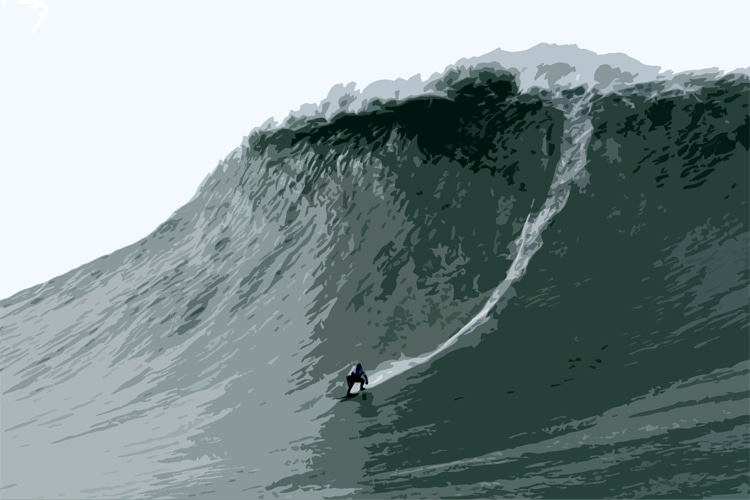How do the World Surf League (WSL) judges analyze and measure the largest waves ridden each year? The professional surfing circuit developed a new formula for wave height measurement.
In order to determine - or estimate - and formalize wave height measurement standards, WSL teamed up with researchers at the Scripps Institution of Oceanography, University of California, San Diego in La Jolla, and the University of Southern California, Department of Aerospace and Mechanical Engineering in Los Angeles.
The collaboration was initiated to help WSL identify the winner of the 2020 WSL Big Wave Awards Women's XXL event.
The following conclusions were taken from the report "WSL Big Wave Awards 2020 – Wave Height Estimation and Comparisons" developed by Michal Pieszka, Falk Feddersen, Jessi Miley-Dyer, Adam Young, Matthew Spydell, James Matthews, and Adam Fincham.
Here's an edited version of the original 16-page analysis:
There were two candidates: Justine Dupont and Maya Gabeira.
Both athletes surfed waves at Nazaré, Portugal, on February 11, 2020, within a 2.5-hour time span.
The objective is to determine which of the two candidates surfed the bigger wave, knowing that the analysis is based solely on video and photo imagery.
The video and photo data sets are limited and incomplete; this makes the process of estimating wave height quite challenging.
Additionally, the waves were compared to the current woman's world record wave, and an approximation of the nominal wave height will be made.
Environmental Conditions
To improve the measurement method, researchers added relevant variables such as tides, sunlight, wave set-up, and available video and photographic data.
Tides
In the tide chart, one can see that the first high tide was at 3:52 am and the next high tide at 4:18 pm.
The first low tide was at 10:07 am, and the next low tide was at 10:21 pm.
The tidal wave progression yields 3.6 meters maximum amplitude over the entire day.
Based on the documented times of the two candidate waves, 9:36 am and 11:59 am, the WSL team considers that the level of the tide (0.4 m difference) could significantly affect the analysis.
Sunlight
On Tuesday, February 11, 2020, the sun rose in Nazaré at 7:33 am, and sunset was at 6:08 pm.
Lighting conditions for the different imagery are primarily influenced by the location of the photographer, but the images from the earlier wave at 9:36 am, show, as expected, higher contrast due to the lower angle of the sun.
Wave Set-Up
Potential effects of the wave set-up phenomenon on the accuracy of the wave height estimates using the available video data were carefully considered (i.e., local increase and tilt of mean water level in the surf zone due to wave-induced momentum flux).
Given the enormous momentum transfer to the surf zone, the wave set-up at Nazaré can be significantly higher than usual.
This wave set-up can change between the first and last wave on a set and is influenced by the nature of the coast, be it a cliff or beach.
It was decided that any effort to include estimates of the instantaneous wave setup based on the available data would not be beneficial to the objectives of the study.
Available Video and Photographic Data
Video and photographic imagery were provided by the WSL.
The data included several different camera angles and camera types, including some drone footage and that from jet-ski-mounted cameras.
The meta-data available on some of the provided images allowed for the determination of some details of the photographic equipment.
A site plan indicating some of the camera locations and the believed location of the breaking waves was identified.
Using tide information and image rectification techniques presented in the methodology section, WSL estimated that the waves were breaking at the zone designated by the WSL as Outside Peak 1.
Methodology
All analysis was based on the provided image data.
The collinearity equations were used to transform the image coordinates into real-world coordinates based on estimates of the geometric parameters that could be deciphered from the available data.
Firstly, it was important to determine any fixed/constant reference objects present in video/photo data for the contending waves.
WSL started off with the surfers' heights and board dimensions and then estimated their crouching heights (the accuracy of the latter parameter still needs to be refined).
Surfer's Height | Surfboard Length | Est. Surfer's Crouching Height
- Justine Dupont: 5'11'' | 6' | 4'
- Maya Gabeira: 5'7'' | 6' | 4'1''
After reviewing the available data sets, it turned out that the tow-in jet-skis present in some of the videos might constitute helpful reference objects and improve the accuracy of measurements that were initially based solely on the surfers' dimensions.
The make and model of the jet skis were determined by reviewing the available footage, and WSL assumed that no significant modifications to the skis were made.
The length of the tow-in rope was also considered as a candidate, but further investigation led the researchers to believe that the ropes are elastic and designed to stretch so as to sling-shot the surfer into the wave.
This elastic property makes them unsuitable for use as a measuring stick.
A particularly useful dimension was the distance from the front of the ski to the back of the seat.
This was consistently visible despite the white water conditions.
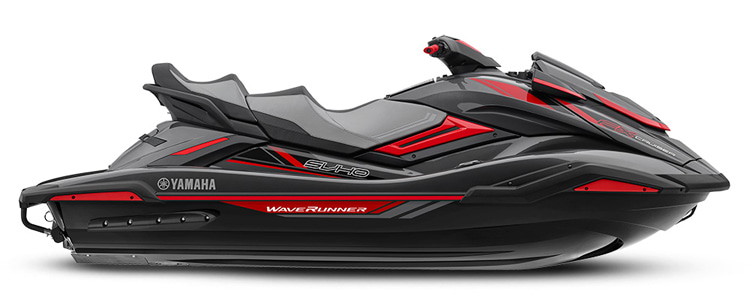
Length | Width | Height
- Yamaha FX class Waverunner (2015-2019): 140.9'' | 50'' | 48.4''
- Yamaha VX class Waverunner: 131.9'' | 48'' | 46.9''
The ski turns out to be the most reliable measuring stick in the available data.
With the intent of providing uniformity within the considered fields of view, WSL grouped the photo data sets based on camera deployment locations and lens parameters/settings.
Images taken from farther away with higher magnification were deemed more useful as the perspective errors are limited.
Basic geometrical relations were used to provide preliminary comparative wave height estimates for the considered cases.
The method allowed for estimating the distances between the cameras and the wave breaking and indicated that both waves broke at very similar locations in the horizontal plane.
Please note that for some of the cases, the image corrections do not include adjustments for 3D water surfaces, which also causes image distortion.
Researchers were able to calculate the distance from Mr. Poullenot to the surfers using the following relation: At the instant where the photos were taken, the distance is approximately 585 meters for Gabeira and 574 meters for Dupont.
This estimate is in line with the map of the observed outside peak zones provided by the WSL.
Consecutively, knowing the camera elevation, the camera tilt angle was determined to be approximately 10.7 degrees.
The internal camera parameters (such as the aspect ratio, the optical center, the distortion coefficients, and the effective focal length f ) are sometimes known.
WSL was able to estimate the camera position and orientation by effectively combining the external and internal camera calibration parameters.
These parameters were used at a later stage to convert the acquired video data images from their "flat'" form in [px] to a 3D representation of the wave with its height given in units of length.
The conversion process involved collinearity equations.
2020 Big Wave Awards Wave Comparison
In order to determine which of the two candidate waves from the 2020 Nazaré session were bigger, photos from the available data set were located that were taken with the same fixed focal length lens (400 mm), from the same location, by the same photographer.
These were chosen as they were believed to be the best assets to use for the comparison.
The surfer's silhouettes were overlapped in a single shot and carefully inspected pixel-by-pixel.
Both surfers are comparable in size, confirming, based on the knowledge of having the same camera lens and photographer's location, that the waves are breaking at approximately similar distances from the photographer.
After the mutual validation of the reference points, the original full-size photos of both waves were adjusted for slightly differing tilt angles and juxtaposed side-by-side.
The red and yellow lines indicate the determined locations of the crest and trough, respectively.

The difficulty in comparing these two waves comes down to identifying both the crest and the trough of each wave in the images.
The location of the crest can be validated by careful examination of the various video streams that show its time progression.
The trough is harder to identify, but by comparing video footage from the jet-ski that shows the wave in profile (see below), it is possible to improve one's estimate of the trough location in the frontal images.
This procedure allowed improved confidence in the trough locations identified in the above figure.

The waves are very comparable in height, but as can be seen from the indicated locations of the trough, the wave on the left is slightly larger.
Additionally, it seems that the surfer in the left image (Maya Gabeira) dropped in closer to the wave peak.
The photo on the left (Gabeira) was taken at a later stage of wave breaking - theoretically, a shoaling plunging breaker reaches its maximum height right before its lip starts dropping down.
Thus, this wave could have been even bigger at its maximum than at the instant presented in Poullenot's shots.
At this preliminary stage of the analysis, it was concluded that Maya surfed a bigger wave than Justine.
In the next section, WSL quantifies the height of these two waves.
Quantification of Wave Height
In order to get an estimate for the height of the two candidate waves, it was decided to use a statistical approach where several images would be selected from the different video streams, the methodology described above would be applied, and the results averaged.
The following figures present snapshots from the analysis of the available video/photo-data sources for Maya Gabeira and Justine Dupont, respectively.
Red lines in the figures denote the identified wave crests, and yellow lines denote the approximate wave trough locations.
The data sources were designated using the original file names provided.
Maya Gabeira
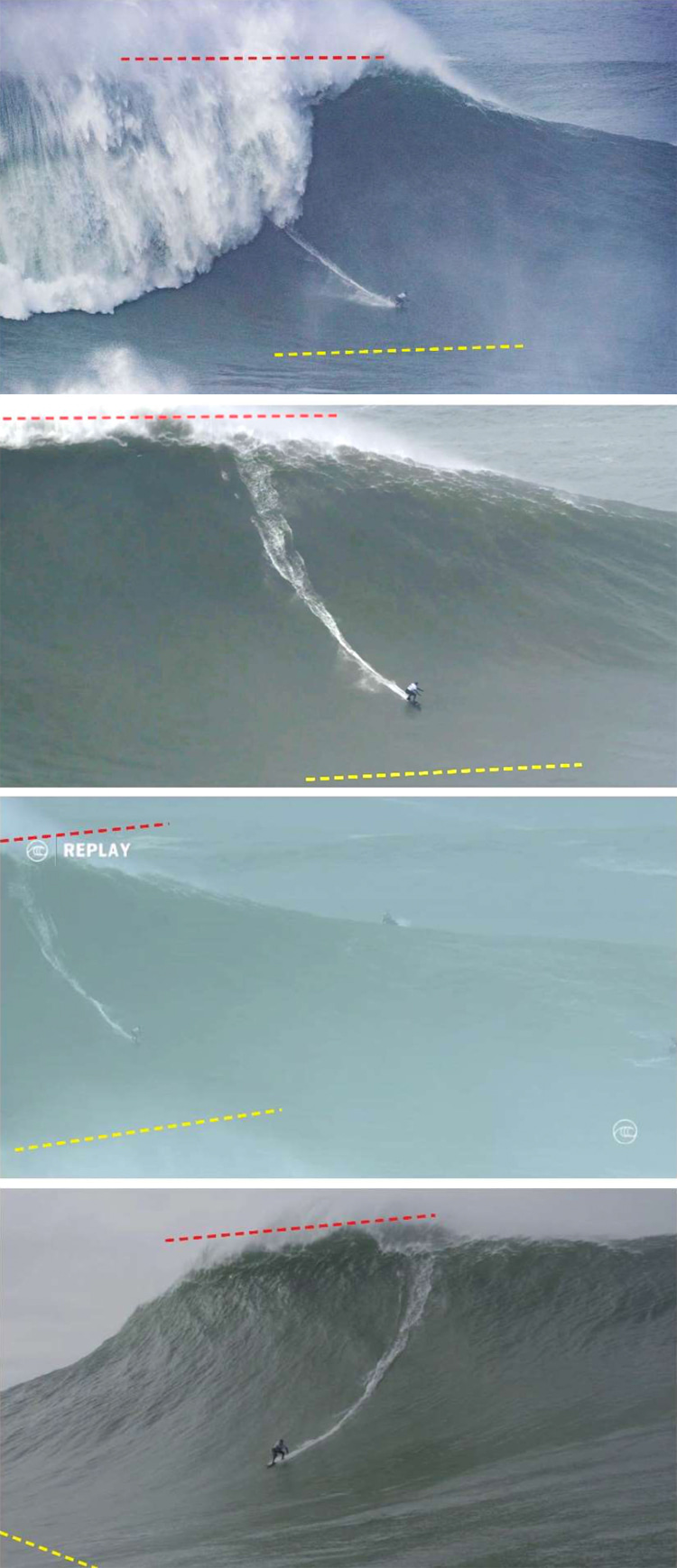
Justine Dupont
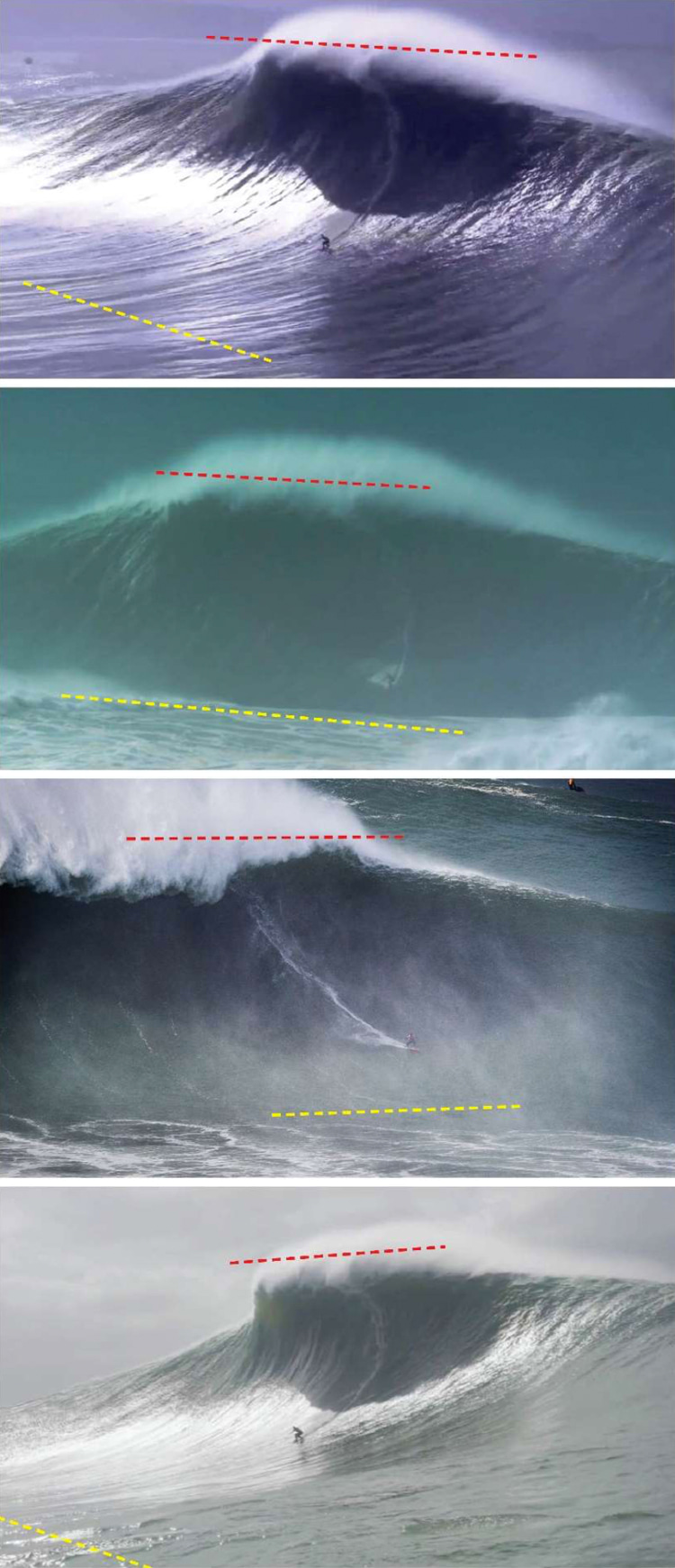
In most cases, jet-skis were used as the measuring stick due to their more reliable length representations.
As best as the geometric parameters could be determined, the methods described above were applied to the available images.
The data indicates that the wave Maya Gabeira rode is approximately 2-3 feet larger than that of Justine Dupont.
Conservatively, the height of this wave is estimated at 73.5 feet from trough to crest.
The error bar ranges for the estimated wave heights were established based on video quality, video resolution, and uncertainties related to perspective strength, dull lighting, etc.
Although there are likely other sources of error, the fact that the same procedure was applied to the two waves in question reaffirms that despite the possibility that numerical values determined for the wave heights could be off, Maya's wave is once again determined to be larger.
New World Record
The current women's world record held by Maya Gabeira is 68 feet and was surfed at the same location in Nazaré in 2018.
The quantitative estimates we made indicate that the new world record should be approximately 73 feet.
The WSL provided footage of the 2018 wave allowing for a comparison. An effort to compare these two waves was made.
The available data sets were from two different sources.
A video frame from 2018 was carefully selected to provide a comparative representation of the wave (at a very similar phase of breaking).
Efforts to compare them involved matching the framing (zoom level); this was modified to match the surfer's size as a reference object.
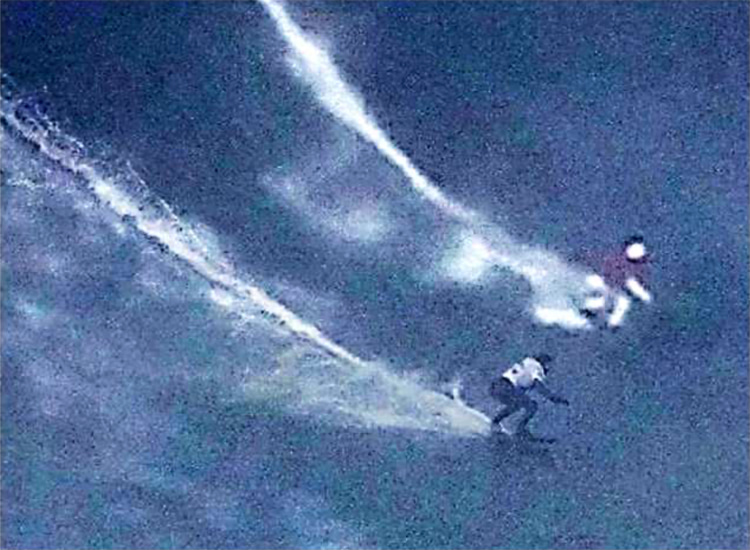
The framing was then panned vertically to match the position of the wave crests.
Again - even though it's very challenging to determine the exact wave troughs locations from the limited data set - it appears that although these waves are very similar in size, the 2020 wave is slightly bigger (see below).
Another observation based on looking at the surfboards trace in the images is that in the 2020 wave, Maya dropped into the wave closer to the wave peak (where the wave is taller), solidifying this new world record.

Closing Remarks
Basic methods of image processing were successfully applied to the available image data to determine a winner for the 2020 Women's XXL competition.
The results indicated a new world record for the largest wave ridden by a woman.
There was much learned in this process that should streamline similar analysis in the future.
Emerging remote sensing technologies, such as lidar and stereo cameras, provide new opportunities to map the three-dimensional ocean surface with unprecedented detail.
These tools provide a method to more accurately quantify wave height and improve present methods (such as those used here), which are based on single-frame photographs and expert judgment.
Monitoring systems could range from permanent land-based sensors to rapidly deployed drone or boat-based systems.
These systems have the potential for near real-time wave height output and could provide other wave parameters such as wave steepness and barrel size.
A proposal will be made to the WSL for the implementation of some of these more advanced methods for the 2021 season.
The Surfers' Reactions
Despite developing and delivering an in-depth study and methodology, the conclusions divided fans and athletes.
Justine Dupont strongly disagreed with the outcome.
"WSL based on a report from scientists who use the word 'approximate' in their statement," wrote the French surfer.
"It was stipulated that the size of both surfers is approximately identical, which is false, that both waves were ridden from an approximately same distance from the photographer, which is false."
"They also define the bottom of the wave of the other surfer [Gabeira] about two meters below where the lip of the wave breaks and used images that were submitted after the deadline date."
Maya Gabeira highlighted WSL's methodology.
"I want to acknowledge the effort the WSL made this year to better their measurement system for the biggest wave award," concluded the Brazilian.
"We know how hard it is to make this a precise number once we only have data from photos and videos after the wave is ridden. And also making the whole measurement process a public document for the 1st time ever."
Explore empirical methods for measuring waves in everyday surfing.
